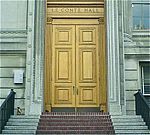Berkeley Jazz Festival
1967 establishments in CaliforniaCulture of Berkeley, CaliforniaFestivals in the San Francisco Bay AreaJazz clubs in CaliforniaJazz festivals in California ... and 3 more
Music of the San Francisco Bay AreaRecurring events established in 1967Tourist attractions in Berkeley, California
The Berkeley Jazz Festival is held once a year at the outdoors Hearst Greek Theatre on the University of California, Berkeley campus. The theatre overlooks the San Francisco Bay at Hearst & Gayley Road. The festival was started in 1967 by Darlene Chan.
Excerpt from the Wikipedia article Berkeley Jazz Festival (License: CC BY-SA 3.0, Authors).Berkeley Jazz Festival
Gayley Road, Berkeley
Geographical coordinates (GPS) Address Nearby Places Show on map
Geographical coordinates (GPS)
| Latitude | Longitude |
|---|---|
| N 37.873611111111 ° | E -122.25416666667 ° |
Address
Hearst Greek Theatre
Gayley Road
94720 Berkeley
California, United States
Open on Google Maps







